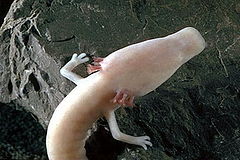|
Odmieńcowate
Odmieńcowate
| Proteidae[1]
|
| Bonaparte, 1831[2]
|
|
|

Przedstawiciel rodziny – odmieniec jaskiniowy (Proteus anguinus)
|
| Systematyka
|
| Domena
|
eukarionty
|
| Królestwo
|
zwierzęta
|
| Typ
|
strunowce
|
| Podtyp
|
kręgowce
|
| Gromada
|
płazy
|
| Rząd
|
płazy ogoniaste
|
| Podrząd
|
Salamandroidea
|
| Rodzina
|
odmieńcowate
|
| Typ nomenklatoryczny
|
|
Proteus Laurenti, 1768
|
| Synonimy
|
- Proteina J.E. Gray, 1825[3]
- Phanerobranchoidea Fitzinger, 1826[4]
- Pododysmolgae Ritgen, 1828[5]
- Phanerobranchi – Wagler, 1828[6]
- Proteina Bonaparte, 1831[2]
- Proteideae – Tschudi, 1838[7]
- Proteidae – Hogg, 1838[8]
- Hypochthonina Bonaparte, 1840[9]
- Protéides – Duméril & Bibron, 1841[10]
- Necturi Fitzinger, 1843[11]
- Necturina Bonaparte, 1845[12]
- Hypochthonidae – Bonaparte, 1850[13]
- Necturidae – Bonaparte, 1850[13]
- Proteida – Jan, 1857[14]
- Menobranchida Knauer, 1878[15]
- Hylaeobatrachidae Lydekker, 1889[16]
- Hylaeobatrachoidea – Kuhn, 1965[17]
- Proteoidea – Dubois, 2005[18]
- Proteinae – Blackburn & Wake, 2011[19]
- Necturinae – Blackburn & Wake, 2011[20]
- Phanerobranchinae – Dubois & Raffaëlli, 2012[21]
- Proteoidae – Dubois & Raffaëlli, 2012[21]
- Phanerobatrachinae Dubois & Ohler, 2015[22]
|
|
| Rodzaje
|
|
|
|
|
|
|
Odmieńcowate (Proteidae) – rodzina płazów z rzędu płazów ogoniastych (Caudata).
Występowanie
Wschodnie USA i granicząca Kanada; adriatyckie wybrzeże, najbardziej wysunięty na północ region Istrii i na południe aż do Czarnogóry; izolowana populacja w północno-wschodnich Włoszech[23].
Charakterystyka
Posiadają niewielką głowę, małe lub szczątkowe oczy, słabe kończyny. Długość ciała wynosi od 12 do 50 cm. Wszystkie gatunki są neoteniczne. Żyją w wodzie, oddychają za pomocą skrzeli. Żywią się bezkręgowcami, małymi rybkami, skrzekiem, ikrą i kijankami.
Systematyka
Do rodziny należą następujące rodzaje[23]:
Przypisy
- ↑ Proteidae, [w:] Integrated Taxonomic Information System (ang.).
- ↑ a b Ch.-L. Bonaparte. Saggio d’una distribuzione metodica degli Animali Vertebrati. „Giornale Arcadico di Scienze Lettere ed Arti”. 49, s. 77, 1831. (wł.).
- ↑ J.E. Gray. A synopsis of the genera of reptiles and Amphibia, with a description of some new species. „Annals of Philosophy”. Second Series. 10, s. 215, 1825. (ang.).
- ↑ L.J.F.J. Fitzinger: Neue Classification der Reptilien nach ihren Natürlichen Verwandtschaften nebst einer Verwandtschafts-Tafel und einem Verzeichnisse der Reptilien-Sammlung des K. K. Zoologisch Museum’s zu Wien. Wien: J.G. Heubner., 1826, s. 43. (niem.).
- ↑ F. von Ritgen. Versuch einer natürlichen Eintheilung der Vögel. „Nova Acta Physico-medica Academiae Caesareae Leopoldino-Carolinae Naturae Curiosorum”. 14, s. 277, 1828. (niem.).
- ↑ J.G. Wagler. Vorläufige Uebersicht des Geruftes, sowie Untungigung feines Systema amphibiorum. „Isis von Oken”. 21, s. kol. 859, 1828. (niem.).
- ↑ J.J. von Tschudi: Classification der Batrachier mit Berücksichtigung der fossilen Thiere dieser Abtheilung der Reptilien. Neuchâtel: Petitpierre, 1838, s. 26, 97. (niem.).
- ↑ J. Hogg. On the classification of the Amphibia. „Annals of Natural History”. 1, s. 152, 1838. (ang.).
- ↑ Ch.-L. Bonaparte. Prodromus systematis herpetologiae. „Nuovi Annali delle Scienze Naturali”. 4, s. 101, 1840. (łac.).
- ↑ A.M.C. Duméril & G. Bibron: Erpétologie Genérale ou Histoire Naturelle Complète des Reptiles. Cz. 8. Paris: Roret, 1841, s. tabela obok strony 53. (fr.).
- ↑ L. Fitzinger: Systema reptilium. Fasciculus primus, Amblyglossae. Vindobonae: Braumüller et Seidel, 1843, s. 35. (łac.).
- ↑ Ch.-L. Bonaparte: Specchio Generale dei Sistemi Erpetologico, Anfibiologico ed Ittiologico. Milano: Coi Tipi di Luigi di Giacomo Pirola, 1845, s. 6. (wł.).
- ↑ a b Ch.-L. Bonaparte: Conspectus Systematum. Herpetologiae et Amphibiologiae. Wyd. Editio altera reformata. Lugdini Batavorum: E.J. Brill, 1850, s. 1 p. (łac.).
- ↑ G. Jan: Cenni sul Museo Civico di Milano ed Indice Sistematico dei Rettili ed Anfibi Esposti nel Medesimo. Milano: Luigi di Giacomo Pirola, 1857, s. 55. (wł.).
- ↑ F.K. Knauer: Naturgeschichte der Lurche. (Amphibiologie.) Eine umfassendere Darlegung unserer Kenntnisse von dem anatomischen Bau, der Entwicklung und systematischen Eintheilung der Amphibien sowie eine eingehende Schilderung des Lebens dieser Thiere. Wien: A. Pichler’s witwe & Sohn, s. 96. (niem.).
- ↑ R. Lydekker: Part III. Palaeozoology. Vertebrata. W: H.A. Nicholson & R. Lydekker: A Manual of Palaeontology for the Use of Students; With a General Introduction on the Principles of Palæontology. Wyd. 3. Cz. 2. Edinburgh and London: William Blackwood and Sons, 1889, s. 1040. (ang.).
- ↑ O. Kuhn: Die Amphibien: System und Stammesgeschichte. München: Oeben, 1965, s. 39. (niem.).
- ↑ A. Dubois. Amphibia Mundi. 1.1. An ergotaxonomy of Recent amphibians. „Alytes”. 23 (1), s. 20, 2005. (ang.).
- ↑ Blackburn i Wake 2011 ↓, s. 46.
- ↑ Blackburn i Wake 2011 ↓, s. 47.
- ↑ a b A. Dubois & J. Raffaëlli. A new ergotaxonomy of the order Urodela Duméril, 1805 (Amphibia, Batrachia). „Alytes”. 28, s. 77–161, 2012. (ang.).
- ↑ A. Dubois & A. Ohler. An often overlooked Rule of the Code, and its bearing on the authorship and date of the nomen Proteidae (Amphibia, Urodela). „Bionomina”. 9, s. 45, 2015. DOI: 10.11646/bionomina.9.1.4. (ang.).
- ↑ a b D. Frost: Proteidae Gray, 1825. [w:] Amphibian Species of the World 6.1, an Online Reference [on-line]. American Museum of Natural History. [dostęp 2022-05-09]. (ang.).
- ↑ Praca zbiorowa: Zwierzęta: encyklopedia ilustrowana. Warszawa: Wydawnictwo Naukowe PWN, 2005, s. 442. ISBN 83-01-14344-4.
Bibliografia
Identyfikatory zewnętrzne:
|
|